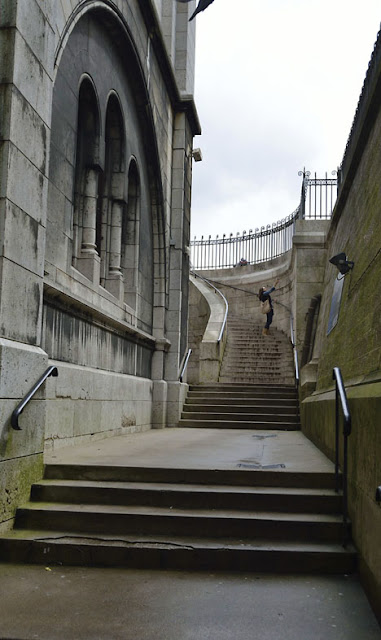Sacré-Coeur basilica
On the tallest hill in Paris (in the Montmartre district) stands
the Sacré-Coeur basilica. Built over a 39-year period (1875 to 1914) after the
Prussians and the Commune defeated France, it was said to be atonement for the
deterioration of religious faith of the French of the period that they believed
was the source of their defeat.
 It’s unfortunate that interior photos are not allowed (there
are docents scattered among the crowds that actively enforce this prohibition
as well as the requirement for silence) in the Basilica because it remains a
community church and active house of worship.
(If only the Italians were as effective in monitoring the Sistine
Chapel!) However, Wikipedia does have a free-licensed interior image of the
apse mosaic that is worth sharing (credit Didier B).
It’s unfortunate that interior photos are not allowed (there
are docents scattered among the crowds that actively enforce this prohibition
as well as the requirement for silence) in the Basilica because it remains a
community church and active house of worship.
(If only the Italians were as effective in monitoring the Sistine
Chapel!) However, Wikipedia does have a free-licensed interior image of the
apse mosaic that is worth sharing (credit Didier B).
Though one is denied the opportunity to photograph the
interior, one can climb the 300 steps to the walkway that surrounds the main
dome to get a view of Paris that is rivaled perhaps only by that from the
Eiffel Tower (which can itself be seen from the dome walkway). The stone spiral staircase that leads up to
the catwalk is barely wider than an adult human being. Rainwater finding its
way down its circumference made for tricky footing, but the payoff is one
magnificent, 360-degree view of Paris, especially as the rain clouds of the day
began clearing.
It’s also an opportunity to get a close up view of gargoyles commonly seen in historical cathedrals.


This stairway leads to the church basement where we picked up the 300-stair path to the exterior catwalk surrounding the dome. Several images below Eileen is standing in the catwalk where you can see that it is not much wider than she. You can also see the Eiffel Tower in the distance if you look into the mist. The small image to the right is of the covered section of the catwalk.
It’s also an opportunity to get a close up view of gargoyles commonly seen in historical cathedrals.


This stairway leads to the church basement where we picked up the 300-stair path to the exterior catwalk surrounding the dome. Several images below Eileen is standing in the catwalk where you can see that it is not much wider than she. You can also see the Eiffel Tower in the distance if you look into the mist. The small image to the right is of the covered section of the catwalk.
 Gargoyles often serve
as water spouts to direct rainwater away from the foundations in addition to
being didactic imagery that often scares the stuffing out of children.
Gargoyles often serve
as water spouts to direct rainwater away from the foundations in addition to
being didactic imagery that often scares the stuffing out of children.



The Montmartre area (18th Arrondissement) is extremely hilly. So steep in fact that steps are carved into the various hills to make them negotiable on foot. Even this extreme grade does little to dampen the enthusiasm of those who simply want to bask in the splendor of the area by laying out in the sunny skies in the Place Saint Pierre for a bit with a bottle of wine and a picnic spread. If you look carefully you can see Eileen in the center clearing (wearing a black jacket) waving to you.
The park goes on for several terraced levels dotted with
walkways, stairways, grottos and plaza plus the hallmark of almost every French
formal park, a carousel.
Access to the base of this park from the closet Metro station, Anvers, is via a 250-step walkway after climbing two rather steep streets. For those less inclined, (pun intended) a modern funicular eliminates the need to climb one section of steps.
Or you could approach the site by navigating the streets of the Place du Tertre. It’s one of the most tourist visited areas of Paris. Much like the medieval castles of old, the Basilica is surrounded by commerce, packed with cafés, street artists, confectionaries, caricature artists and even fine art studios and museums.
The Halle Saint Pierre has a wonderful art bookstore on the
first floor as well as several galleries and exhibition halls on the second
floor.
Just down the street is the Musée de Montmartre (the one with the Chat Noir banner) that is a museum of the history of the area and past art studio to Renoir, Susanne Valadon and Maurice Utrillo. It was also home to writer Léon Bloy and poet Pierre Reverdy. It features a vineyard that has been active since the middle ages.

On the Rue Turgot there are several shops that provide the ambiance of Filene’s Basement in Boston.
But, alas a few steps away is the Le Petite Musée du Hocolat, a rather extensive collection of chocolate confections.
Both the square rigger ship and the Notre Dame cathedral are of course made of chocolate. I do find it a bit ironic that in the shadow of the Sacré Coeur they chose to feature Notre Dame. French macaroons get their own display.























I loved being so close to a gargoyle I could almost touch it. Seeing that they also had an 'earthly' purpose made them less frightening!
ReplyDelete